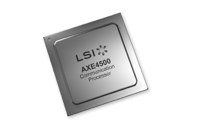ARM processors fuel the millions of video-ready smartphones and tablets that are pushing wireless telecom equipment to its limits with growing bandwidth demands, but they have done little to help transmit that data overload. That’s about to change. Much has been made of the growing role of ARM Cortex-A15 system-on-chips in the x86-dominated server market, and the greater server inroads expected from upcoming 64-bit, ARMv8 Cortex-A57 cores. Yet these are also the first ARM designs that actively target networking and telecom equipment – which typically run Linux — in addition to mobile and server applications.
 Until recently, ARM SoCs have been primarily limited to networking endpoint devices such as routers and network attached storage devices. Yet, ARM is increasingly seen on network appliances, broadband gateways, and even some small-scale 4G basestations using SoCs like Cavium’s Econa, Marvell’s Armada XP, or Mindspeed’s Comcerto and Transcede. As telecom networks and enterprises face larger electricity bills from networking, there’s growing interest in expanding the power-stingy ARM architecture to play a more central role in telecom.
Until recently, ARM SoCs have been primarily limited to networking endpoint devices such as routers and network attached storage devices. Yet, ARM is increasingly seen on network appliances, broadband gateways, and even some small-scale 4G basestations using SoCs like Cavium’s Econa, Marvell’s Armada XP, or Mindspeed’s Comcerto and Transcede. As telecom networks and enterprises face larger electricity bills from networking, there’s growing interest in expanding the power-stingy ARM architecture to play a more central role in telecom.
PowerPC CPUs still dominate networking and telecom microprocessors, chiefly in the form of Freescale SoCs such as its PowerQUICC and newer QorIQ processors. Yet, the aging, IBM-sponsored Power architecture is expected to fade quickly over the coming years, with Intel x86 and ARM processors taking up the slack. According to 2012 estimates from the Linley Group, x86 is the fastest growing networking architecture, with MIPS in third place, and ARM far behind.
MIPS has slipped a bit, but is still in a strong position, with MIPS64 processors from Cavium (Octeon) and Broadcom (XLP) entrenched in high-end networking. New MIPS owner Imagination Technologies is looking to revive the architecture with an upcoming “Warrior” family of MIPS processors.
Signs of ARM’s Networking Rise
ARM’s networking share may be miniscule, but it’s beginning to make its move. Recent signs and portents include:
Linaro’s LNG — In February, ARM’s not-for-profit Linaro development firm formed a Linaro Networking Group (LNG) with members including chipmakers like ARM, AppliedMicro, Freescale, LSI, and Texas Instruments (TI). The goal is to define requirements for optimizing networking applications on ARM.
MontaVista, Wind River gain ARM CGL certification — For the first time this year, the Linux Foundation’s Carrier Grade Linux (CGL) group has registered Linux distros for the CGL spec using ARM platforms.
Cavium’s Project Thunder – MIPS leader Cavium has for several years offered an Econa line of ARM SoCs for low-end networking, but the high-end has been devoted to its MIPS64-based Octeon chips. Last year, Cavium announced new Project Thunder SoCs, which will harness 64-bit ARMv8 cores for Octeon-like networking and enterprise duty. In January, Cavium and Fedora announced a Linux SDK for Project Thunder.
TI’s Keystone II — One of the first ARM SoCs aimed at high-end networking and server duty has begun to ship. TI’s “Keystone II” TCI6636 SoC combines four 28nm Cortex-A15 cores with eight C66x DSP cores, and adds networking and security co-processors to handle packet processing.
Freescale QoriQ LS – PowerPC leader Freescale will soon sample its first QorIQ processors to use ARM instead of PowerPC. The QorIQ LS SoCs use a new Layerscape architecture that supports either PowerPC or ARM cores. The QorIQ LS-2 features two Cortex-A15 cores running at up to 1.5GHz with  under 5W power consumption. Freescale also says it is licensing ARM’s Cortex-A57 design for future QorIQ networking SoCs.
under 5W power consumption. Freescale also says it is licensing ARM’s Cortex-A57 design for future QorIQ networking SoCs.
AppliedMicro X-Gene — In early April, AppliedMicro, the other major PowerPC vendor after Freescale, announced its first ARM processor, a 64-bit, ARMv8 X-Gene SoC. Although the X-Gene is primarily aimed at servers, enterprise networking systems should also benefit. The X-Gene is said to be the first processor to contain a software-defined networking (SDN) controller on die, enabling it to provide network services like load balancing.
LSI Axxia — In January, MIPS and PowerPC chip vendor LSI Corp. announced its first ARM SoC aimed at next generation networks. The 28nm Axxia 4500 combines up to four Cortex-A15 cores with ARM’s new networking-focused CoreLink CCN-504 interconnect, plus SDN technology, and up to 100Gb/s of L2 switching functionality. In February it announced a similar Axxia 5500 SoC that supports up to 16 Cortex-A15 cores.
Intel’s Crystal Forest stakes a NEP claim
ARM is likely to trail other architectures in networking for years, but as PowerPC fades, it shares the momentum along with Intel. The x86 giant has a huge head start, however, benefiting from the fact that performance still trumps price and power consumption among networking customers, according to a survey by HeavyReading.
Intel sold off its ARM-based XScale/IXP networking chip business to Marvell in 2006, but is now finding success pushing its x86-based Xeon processors into networking gear. Last fall, Intel unveiled a “Crystal Forest” chipset that could prove to be catnip to NEPs (network equipment providers). The chipset combines Xeon cores with “QuickAssist” hardware for accelerating cryptography, packet processing, and deep-packet inspection. Among other targets, Crystal Forest is focused on emerging Cloud RAN, or C-RAN (Radio Access Network) basestations that offload processing to cloud servers.
ARM, however, could also benefit from the C-RAN craze, with SoC’s like Keystone II and X-Gene providing support. ARM is also favored by the trend toward smaller scale pico- and femto-cell basestations rather than macrocell basestations. Here, ARM’S performance/power ratio may well prove more attractive than x86 or MIPS designs. Then again, Intel’s low-power, 22nm Silvermont processors will be released in a networking SoC design in addition to other mobile and enterprise SoC platforms.
No matter which platform dominates in telecom, it’s all good for Linux developers. Linux continues to be the leader in networking and telecom on all major processor architectures capable of running an advanced OS. With demands growing for more powerful and sophisticated equipment, Linux should continue to siphon off market share from real-time operating systems, ARM or no ARM.


